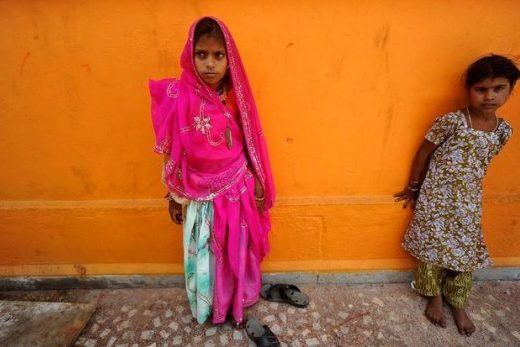Child marriage is a formal union where one or both of the parties are under 18 years old. In many places around the world, marriage under the age of 18 is part of a culturally accepted norm, and about 10% of the global population has been married before their 18th birthday. 1
However, in certain cases, child marriage can amount to slavery. At Freedom United, we use these indicators to help determine when child marriage constitutes slavery:
- a child has not genuinely given their free and informed consent, for example, being given in marriage against his or her will;
- a child being subjected to control, a sense of “ownership” through abuse and threats, and is exploited for their labor and/or non-consensual sexual activity once within a marriage;
- the inability of a child to leave a marriage he or she no longer wishes to remain in.
The younger a child is, the less control they have to give their free consent to marriage and the more vulnerable they may be to slavery.
Girls who are victims of forced child marriage can find themselves subjected to abuse, sexual exploitation, and control, with little or no power over their own movements. Often, the girl will be controlled through violence, threats, and humiliation, and find herself unable to safely leave the marriage.
What does child marriage look like around the world?
Quote: “The marriage – it didn’t go well. Each time my husband wanted to make love to me, he would beat me. He wouldn’t allow me to leave the house. I felt so depressed that I tried to take my own life.”2 Lamama, 15, Cameroon
Lamama was forced out of school to marry her husband, and sadly her story is just one of many. Statistics suggest that one-third of girls in the developing world are married before the age of 18, whilst one in nine enter into marriage before the age of 15.3 If this trend prevails, 150 million girls will be married before their 18th birthday over the next ten years.4 Although boys are also married as children, girls are more disproportionately affected by child marriage. This is often because girls are not valued as highly as boys in the communities where child marriage takes place – in these cases, marriage may be seen as a way of easing the economic burden on the girl’s family.
Child marriage thrives in many countries, yet it is most commonly found in South East Asia and sub-Saharan Africa, with Niger found to have the highest proportion of child marriage with 76% of girls married before they’re 18.5 Child marriage tends to occur in rural areas more than in urban areas. This is because rural areas are typically more impoverished and consequently, prospects for girls are more limited. Rural areas often have more traditional outlooks where girls who are unmarried have the pressure of societal disapproval. Figures also show that girls from poorer backgrounds were more likely to be child brides; females in the poorest quintile are 2.5 times more likely to be implicated in child marriage than those living in the wealthiest quintile.6
What are the causes of forced child marriage?
There are many factors that contribute to child marriage around the world. Often, these contributing factors propagate an environment that encourages forced child marriage and increases the vulnerability of children to slavery. In this section, we’ll discuss a few of the main causes:
Poverty: In the developing world, over half of girls from the poorest families are married as children.7 For some families, giving a daughter in marriage is a way to reduce expenses – particularly if a son’s education and expenses are prioritized. In some communities, the groom and his family will expect a dowry from the bride’s family – with the idea this money will ensure her care for the foreseeable future. Often, the younger the girl is the lower her dowry – this is because she will be seen to be easier to control in her new home and more likely to be a virgin.
Social & Religious Traditions: In many areas, it is the norm to marry children young. Peer pressure can force parents into marrying their children and can place pressure on young girls to conform to marriage or else expect to be viewed as a “nasty, disrespectful girl”.8 The fear of pregnancy outside marriage is a major driver, and early marriage is seen a way to safeguard against such immoral behavior.
Gaps in the law and the failure of law enforcement: A lack of strong, effective legislation protecting girls or creating a minimum age of marriage is a key factor. However, even when there are laws in place, law enforcement may not reach into rural areas or may not have the training to deal with cases of forced or underage marriage. Many law enforcement individuals may not view it as their responsibility to interfere with family affairs, or corruption in the system allows perpetrators to pay money to delay or avoid court procedures.
What is the state of Forced Child Marriage in Niger?
Case Study9:
Aysha* was married at 13 to a wealthy Nigerian from the city of Kano. Forced to leave her home for the Nigerian city of Kano, Aysha found herself alone and vulnerable – imprisoned in her new husband’s home. “He was always trying to make it clear that it was as if he had bought me, that it was not because I wanted him but because he had bought me.” After 10 days of marriage, Aysha’s husband locked her in the bedroom. ” One day he locked me in the bedroom… It is as if he raped me”. Fortunately for Aysha, her brother helped her to escape and she is now studying to be a nurse. Many other girls from Niger aren’t so lucky.
* Not her real name
“There is no room for women to dream dreams”. Amina, Niger
Niger has the highest rate of child marriage in the world. 76% of girls are married before they are 18 and 28% before they are 16.10 Child marriage in Niger is rooted in poverty and social norms which expects girls to marry young to protect their honor and prevent pregnancy outside of marriage – a tradition that is upheld by religious leaders.11
Young girls are also at risk of the practice of ‘Wahaya’. This is the name given to members of the slave caste who are brought and sold as unofficial wives in Niger. Often referred to as the ‘fifth wife’, these girls act as an addition to the four wives legally permitted to Niger men. Unfortunately, without the legal status of marriage, these ‘Wahaya’ have none of the rights and protection that legal wives have. ‘Wahaya’ are essentially slaves used for domestic labor and sexual gratification.12
The President of Niger, Mahamadou Issoufouhas, has publicly declared his intent to address the escalating problems of child marriage by investing in programs that he says will reduce the prevalence of child marriages from 60% to 40%.13 Despite the government committing to several regional efforts to tackle the issue, including the African Union Campaign to End Child Marriage, little has changed. while the legal age of marriage for boys is 18 – the legal age of marriage for girls remains at 16.
What is being done to tackle forced child marriage?
By tackling early child marriage in countries where girls are vulnerable to slavery, we can help put an end to forced child marriage and slavery. On a global level, there has been some progress made towards this goal. In 2015, a target on tackling child marriage was included in the UN Sustainable Development Goals: “Eliminate all harmful practices, such as child, early and forced marriage and female genital mutilations”.14 This target urges member states to put in place policies and practices to abolish child marriage by 2030. However, there is a lot of work to be done to help end the practice of early child marriage:
- Working with communities to change attitudes towards girls and to ensure that they are more highly valued.
- Supporting girls to stay in school and continue their education.
- Providing safe spaces and support networks for girls at risk of child marriage.
- Engaging with religious leaders to encourage them to take a greater role in condemning child marriage and changing community attitudes.
- Working with men and boys to change patriarchal attitudes whilst also supporting young people and youth groups to become agents of change.
- Urging local authorities to adopt stronger laws and policies to reduce cases of forced and early marriage.15
- Using media channels to raise awareness and highlight the negative consequences of child marriage and other advocacy and lobbying techniques.
Freedom United is running a campaign to urge the Niger Government to raise the age of child marriage for girls to 18. By raising the age of marriage to 18, we want to allow girls to finish their education and provide them the opportunity to make informed choices, so reducing their risk of falling into forced marriage. You can help by signing our petition here: https://www.freedomunited.org/advocate/child-marriage-in-niger/
Where can I find out more?
Here are some great websites you can check out to find out more about forced child marriage:




